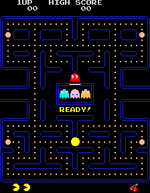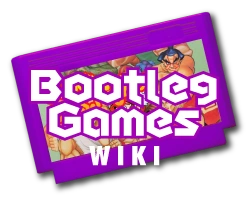PakkuMan47 (talk | contribs) No edit summary Tag: Visual edit |
No edit summary |
||
| Line 1: | Line 1: | ||
[[File:PAC-MAN Logo.png|250px|center]] |
[[File:PAC-MAN Logo.png|250px|center]] |
||
| − | '''''Pac-Man''''' ( |
+ | '''''Pac-Man''''' ({{Mousetext|パックマン|Pakkuman}}), is an arcade game developed by Namco and first released in Japan in May 1980. It was created by Japanese video game designer Toru Iwatani. It was licensed for distribution in the United States by Midway Games and released in October 1980. Immensely popular from its original release to the present day, ''Pac-Man'' is considered one of the classics of the medium, and an icon of 1980's popular culture. |
== ''Pac-Man'' == |
== ''Pac-Man'' == |
||
[[File:PAC-MAN (1980).png|150px|thumb|''Pac-Man'' gameplay.]] |
[[File:PAC-MAN (1980).png|150px|thumb|''Pac-Man'' gameplay.]] |
||
| − | ''Pac-Man'' is an arcade game first released in Japan in May 1980. Developed by Namco, currently known as |
+ | ''Pac-Man'' is an arcade game first released in Japan in May 1980. Developed by Namco, currently known as Bandai Namco Entertainment, it was the debut title in the ''Pac-Man'' series. The game was not intended to be too popular at first, but when released, the game was a huge success and is now the highest-grossing arcade game of all time. This resulted in many sequels and spin-offs of the game, including ''Ms. Pac-Man''. The game has been cloned innumerable times, and re-released on many systems and in many compilations. The player controls Pac-Man, whose design is a yellow circle with a pie wedge shaped mouth, to eat pellets called "Pac-Dots" through a maze. When all dots are eaten, Pac-Man is taken to the next stage. Four ghosts, Blinky, Pinky, Inky and Clyde roam the maze, trying to catch Pac-Man. If a ghost chomps (touches) Pac-Man, a life is lost. When all lives have been lost, the game ends. However, there are also four larger, flashing dots near the corners of the maze known as Power Pellets, which provide Pac-Man with the temporary ability to eat the ghosts, which will turn blue, reverse direction, and move slower for a short period of time. In addition, bonus items, usually referred to as fruits (though not all items are fruits) occasionally appear near the center of the maze, and they score extra bonus points when eaten. The items change and bonus values increase throughout the game. For the bootleg games, they have a few ''Pac-Man'' bootleg games such as ''[[Puckman Pockimon]]'' and ''[[Hangly-Man]]''. |
{{Franchise}} |
{{Franchise}} |
||
| − | [[Category: |
+ | [[Category:Pac-Man games]] |
Revision as of 07:58, 4 February 2020
Pac-Man (パックマン), is an arcade game developed by Namco and first released in Japan in May 1980. It was created by Japanese video game designer Toru Iwatani. It was licensed for distribution in the United States by Midway Games and released in October 1980. Immensely popular from its original release to the present day, Pac-Man is considered one of the classics of the medium, and an icon of 1980's popular culture.
Pac-Man

Pac-Man gameplay.
Pac-Man is an arcade game first released in Japan in May 1980. Developed by Namco, currently known as Bandai Namco Entertainment, it was the debut title in the Pac-Man series. The game was not intended to be too popular at first, but when released, the game was a huge success and is now the highest-grossing arcade game of all time. This resulted in many sequels and spin-offs of the game, including Ms. Pac-Man. The game has been cloned innumerable times, and re-released on many systems and in many compilations. The player controls Pac-Man, whose design is a yellow circle with a pie wedge shaped mouth, to eat pellets called "Pac-Dots" through a maze. When all dots are eaten, Pac-Man is taken to the next stage. Four ghosts, Blinky, Pinky, Inky and Clyde roam the maze, trying to catch Pac-Man. If a ghost chomps (touches) Pac-Man, a life is lost. When all lives have been lost, the game ends. However, there are also four larger, flashing dots near the corners of the maze known as Power Pellets, which provide Pac-Man with the temporary ability to eat the ghosts, which will turn blue, reverse direction, and move slower for a short period of time. In addition, bonus items, usually referred to as fruits (though not all items are fruits) occasionally appear near the center of the maze, and they score extra bonus points when eaten. The items change and bonus values increase throughout the game. For the bootleg games, they have a few Pac-Man bootleg games such as Puckman Pockimon and Hangly-Man.
| List of Franchises |
|---|
|
Contra · Crayon Shin-Chan · Donkey Kong · Doraemon ·Dragon Ball · Mario · Mega Man · Pac-Man · Sonic · Street Fighter |

